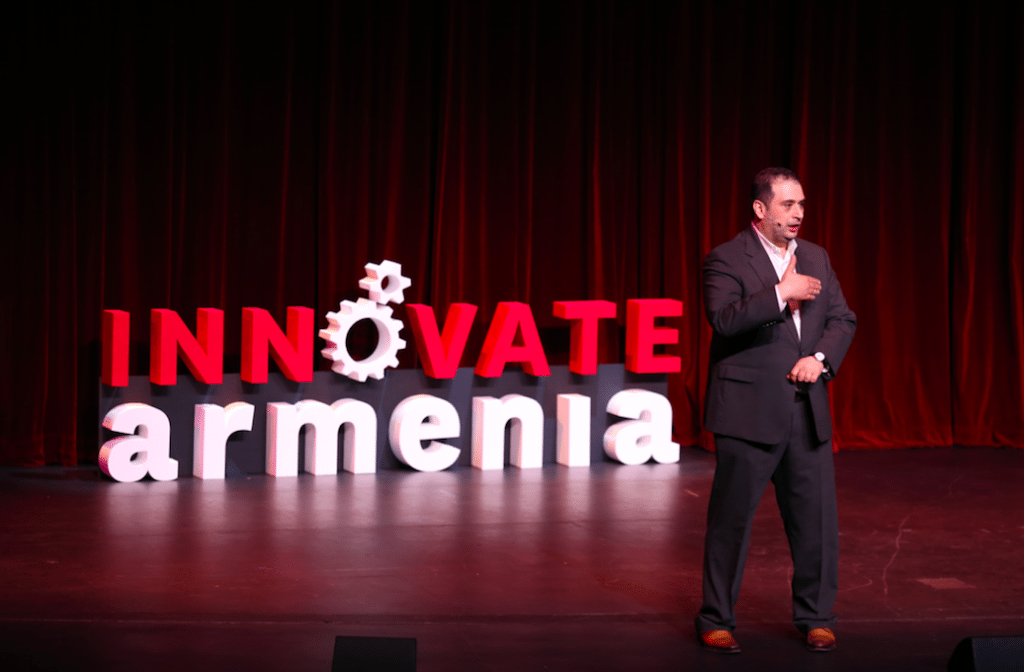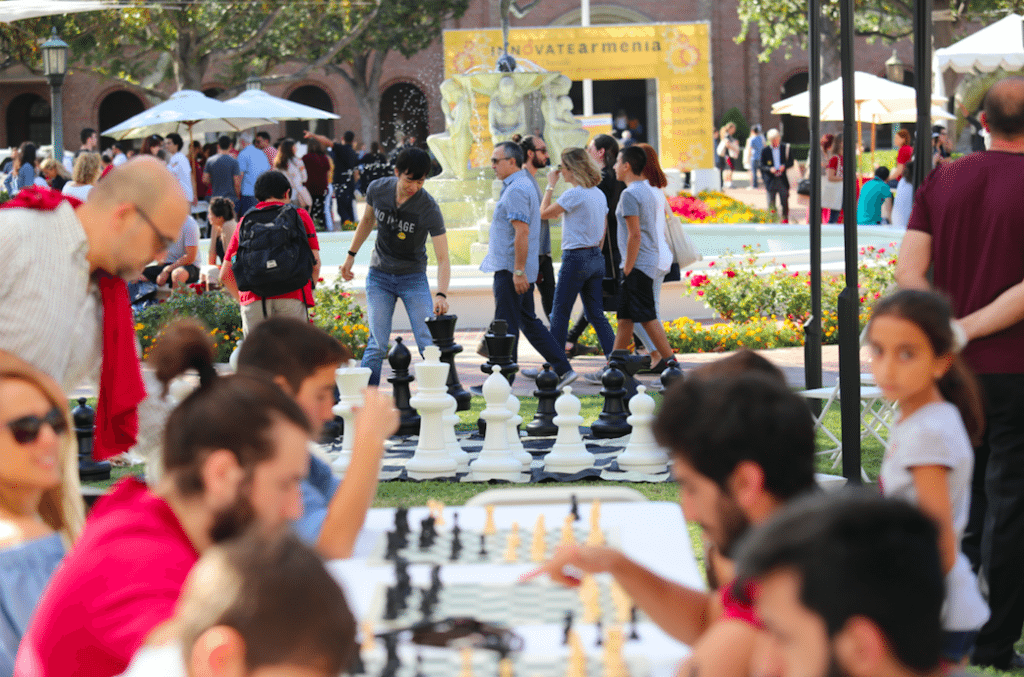LOS ANGELES, Calif.—Sept. 23 was a day to celebrate the Armenian diaspora in all its multicultural splendor—as the University of Southern California (USC) welcomed Innovate Armenia 2017.
The daylong festival, now in its third year, sprawled across Alumni Park into Bovard Auditorium and the Doheny Library, with some 3,000 people in attendance and another 2,000 watching live via internet feeds.
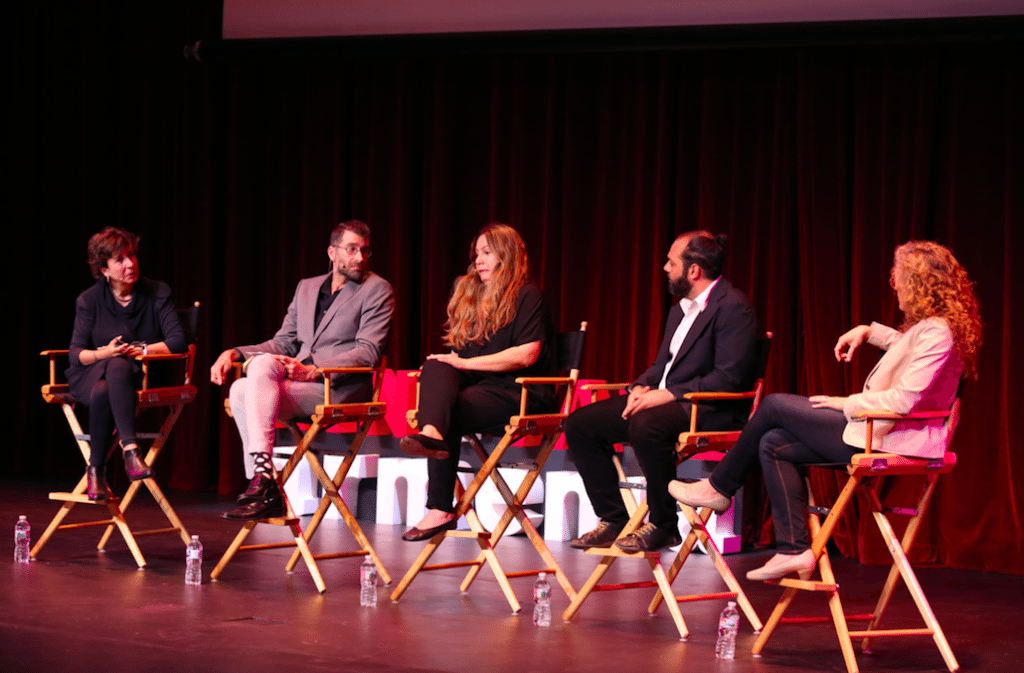
(L to R) Salpi Ghazarian, director of the USC Institute of Armenian Studies; Professor Sinan Birdal of USC, Narineh Mirzaeian, architect; Norair Chahinian, photographer; Professor Lerna Ekmekcioglu of MIT (Photo: USC Institute of Armenian Studies)
Scientists, musicians, entrepreneurs, humanitarians and public intellectuals spoke with many accents from three stages and a dozen special-interest booths.
A century after the genocide, the Armenian diaspora—or “spyurk”—is 7 million strong, with another 3 million living in ancestral lands that gained independence from the Soviet Union in 1991.
These are exciting times to be Armenian, and looking backward is not enough to sustain the community, says festival organizer and USC Institute of Armenian Studies director Salpi Ghazarian. “The 21st century is about reimagining and reinventing so many things—community, identity, society, work, leisure, learning, teaching. Innovate Armenia brings together the best of Armenia with the best of the diaspora,” she said.
That includes Hovig Etyemezian, the Lebanese-Armenian UN human rights worker responsible for protecting nearly a million displaced Iraqis returning to Mosul after its liberation from ISIS control.
It includes Brazilian-Armenian photographer Norair Chahinian, who has chronicled—through his breathtaking images of abandoned spaces and resilient human spirit—a Turkish Armenia that stubbornly refuses to disappear.
And it includes Washington Post foreign affairs columnist David Ignatius, who personifies the diaspora’s hybridity via his Armenian-American father, Anglo-American mother, Swedish-American wife, and Cuban-American son-in-law.
Ignatius, Etyemezian and Chahinian were among the 58 speakers who engaged festival-goers in a non-stop stream of stimulating conversation.
An Atmosphere of Unity
Outside, gyro-style fusion tacos sizzled on open grills, and guests feasted on wraps and salads, feta-topped pita-chip nachos and fried dough peroshkis.
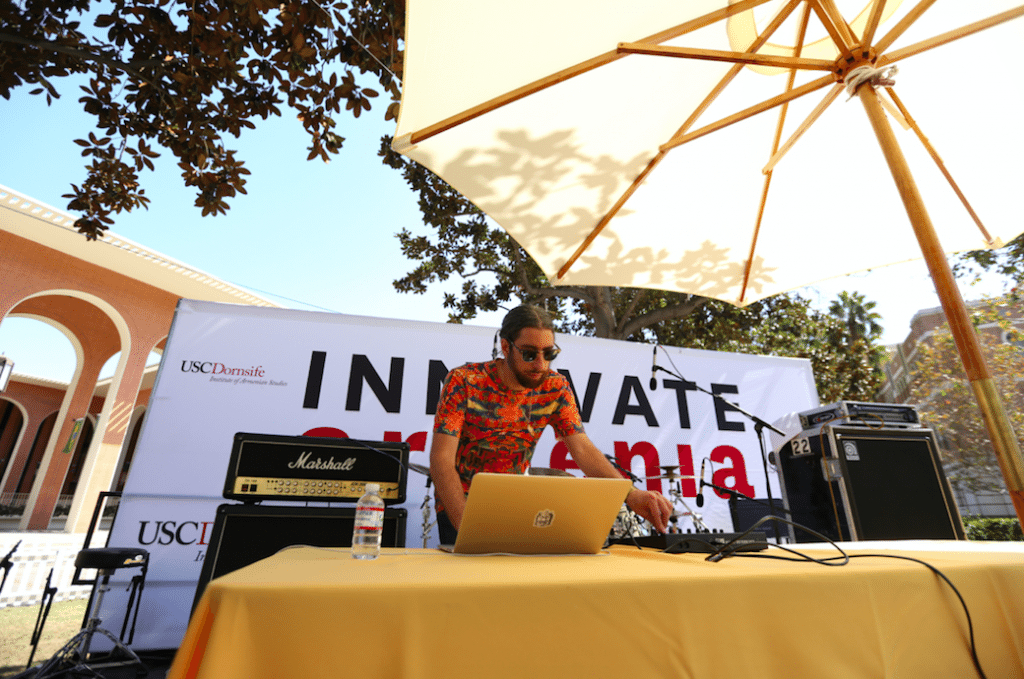
Los Angeles-based DJ Bei Ru presents his music at Innovate Armenia (Photo: USC Institute of Armenian Studies)
“It’s fun,” said Inessa Vardian, a film student from Glendale Community College, nibbling on Nutella-topped pita bread. “I enjoy the atmosphere and the unity, and the fact that the school is very supportive of the event.” Recently returned from a three-month trip to Armenia, Vardian had come with her sister, Agnessa, a USC political science major and festival volunteer.
The sisters ran into a lot of people they knew as Alumni Park churned with activity.
From the music stage, a line-up of eight bands entertained the crowd in styles ranging from pop and jazz to edgy remix that breathed new life into traditional Armenian rhythms and melodies.
Over at the Armenia Wine booth, festival goers sipped ancient vintages dating back to 4,200 BCE—made from regional grapes like the iconic Areni, Haghtanak, Kangun and Rkatiteli. The free tastings were paired with boutique chocolates from Glendale confectioner Bitter & Sweet.
At the chess area, U.S. women’s team member Tatev Abrahamyan played 10 opponents simultaneously, her lavender-magenta-steaked locks defying conventional wisdom about what a chess grandmaster looks like. She and international master Andranik Matikozyan played about 100 games during the festival.
Chess remains extremely popular in Armenia—it’s a formal part of the school curriculum—as demonstrated by young Vartan, 6, who delivered the coup-de-grace to festival volunteer Andrew Nazarians, an electrical engineering student from Glendale Community College.
“I was playing with Tatev and Andranik, and Vartan came in and finished me off,” said Nazarians, with a laugh.
Re-Learning and Re-Imaging
Nearby, at the Teach for Armenia booth, Pasadena native Khachig Choukhajian spoke of his experiences teaching world history last year in a northern Armenian village of 500 people. The UCLA grad is one of 70 teachers currently serving with the international nonprofit that brings progressive methods to rural Armenian schools.

USC students create keychains and Garni Temple models at the Makerspace (Photo: USC Institute of Armenian Studies)
“A lot of the local teachers are products of Soviet education,” Choukhajian explained. “It’s a lot of rote memorization and copying what is written on the board.”
Not all Armenian education is so backwards. Festival exhibitor booths showcased mavericks like the Real School, which brings after-school computer coding classes to youngsters across urban and rural Armenia; and the United World College, a network of 17 international boarding schools that opened its Dilijan campus four years ago, instilling a love of Armenia in the 200 elite students who now study there and may someday be global leaders.
Technology was another prominent theme at this year’s festival.
At a “makerspace” booth, a 3-D printer whirred away, sculpting a miniature Temple of Garni, the famous 1st century pre-Christian ruin outside Yerevan. Armenian-American students from USC’s Viterbi School of Engineering and Glendale Community College demonstrated various robotic-armed rovers they’d built. Nearby, a black, tent-sized solar balloon fluttered in the breeze, part of the USC Viterbi astronautics program’s exhibition space.
On the Bovard stage, a panel of Caltech students described how a humble robotics program at Glendale Community College had opened the door to the nation’s premiere tech institute, where all are now PhD candidates.
A little later, Sphero CEO Paul Berberian described how smartphone-controlled toy robots created by his Boulder, Colorado-based company are making millions of schoolchildren fall in love with math and science.
Cultural Re-Awakening
Other Bovard conversations were darker, but no less uplifting.
Istanbul native Ari Sekeryan, a doctoral candidate in oriental studies at Oxford University, spoke movingly of his own cultural awakening against the backdrop of official Turkish suppression of Armenian identity.
“When I was born in 1989, no one in my family was able to speak Armenian. I cannot forget the very first day of Armenian public elementary school,” he said. “The teacher approached me and asked, in Armenian, ‘What’s your name?’ And I started crying.”
Historians Lerna Ekmekcioglu and Melissa Bilal shared their web-based project documenting the contributions of 12 pioneering Armenian feminists, including the towering author-activist Zabel Yessayan. The Turkish-educated scholars, now both faculty at MIT, see this work as crucial to providing strong intellectual role-models for today’s Armenian women and girls.
Media innovator Arman Jilavian spoke eloquently of a collective yearning in the diaspora for full ownership of Armenian history, language and culture.
“We lost the sense, the status, the self-understanding of owners,” he said. “We are renters.”
In addition to managing several media brands in Russia, Jilavian is CEO of the Aurora Initiative, a $1 million international humanitarian prize awarded annually at a ceremony in Yerevan.
A humanitarian prize based in Armenia sends a powerful message to the world, Jilavian said. “It reshapes and refines our collective identity… It says: ‘We have a global vision. We are not only takers, we are givers.’”
Beyond Victimhood
A hundred years after the genocide, today’s generation of global Armenians are looking to the future, and asking questions about what they can do to make the world better.
“Only when you are able to help others—this is the moment you stop being a victim or survivor, and you start becoming a winner, a person who holds his own life,” Jilavian said.
David Ignatius, in conversation via videoconference with his younger brother Adi Ignatius, editor-in-chief of the Harvard Business Review, echoed Jilavian’s message.
“I think the idea of remembering and honoring the suffering of our ancestors is crucial,” said the columnist, who is also a best-selling author of spy fiction. “But it’s really only when you take action to help others … that you fully move beyond this tragedy of the past.”
The core of the Armenian identity, he suggested, should not be “that we suffer, but that we learned how to help others who suffer.”
As the festival was winding down, Arthur Kokozian of La Crescenta was catching up with Karine Zakarian, an allergist from Glendale.
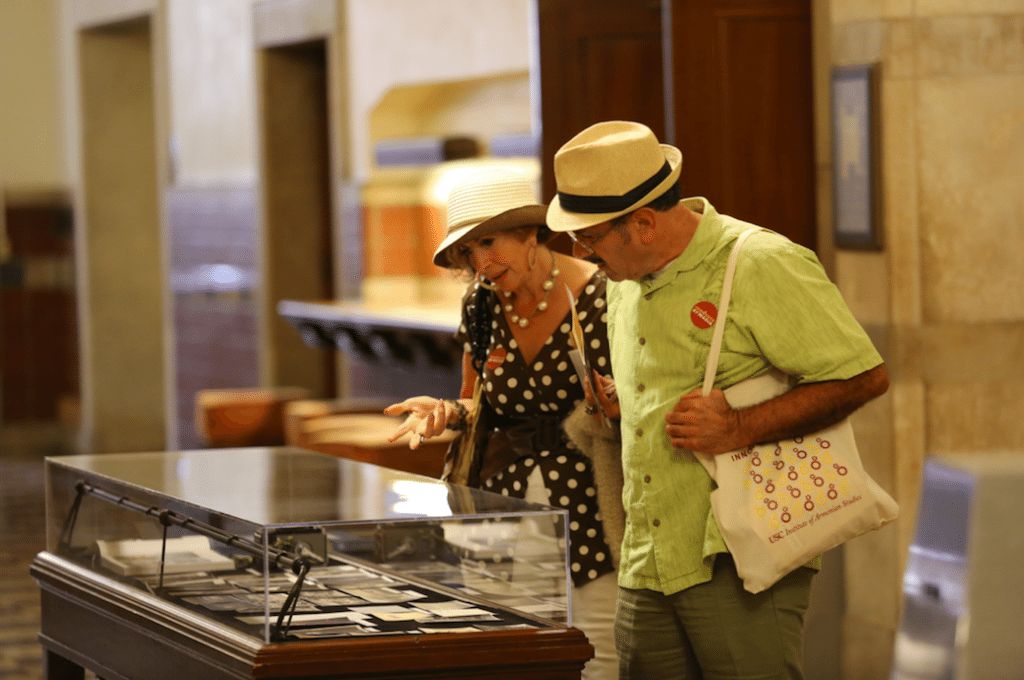
Attendees viewing “Undeliverable” postcard and photography exhibition at USC Doheny Library (Photo: USC Institute of Armenian Studies)
Asked for his assessment of Innovate Armenia 2017, Kokozian, who is president of the American Armenian Rose Float association, had this to say:
“Every year, it’s better and better. I love how the community comes together to see what Armenians in the diaspora are accomplishing, and how we’re working together to get stronger.”
Established in 2005, the USC Institute of Armenian Studies supports multidisciplinary scholarship to re-define, explore and study the complex issues that make up the contemporary Armenian experience—from post-genocide to the developing Republic of Armenia to the evolving diaspora. The institute encourages research, publications and public service, and promotes links among the global academic and Armenian communities.
Source: Armenian Weekly
Link: Innovate Armenia: Scholars, Artists, Thought-Leaders Rethink, Reimagine, and Redefine Identity, Education, Culture


